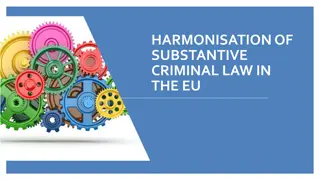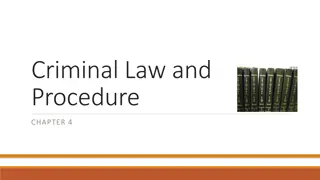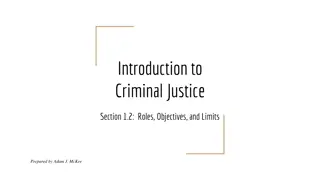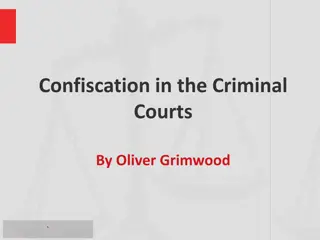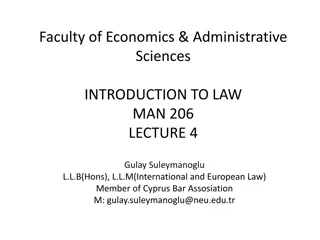Understanding General Criminal Law: Principles and Relationships
General Criminal Law encompasses rules governing offenses and their penalties, exploring the definitions of offenses, relationships with social sciences, other branches of law, and auxiliary sciences. This presentation covers the importance, sources, and branches of criminal law, highlighting its interaction with morality, psychology, civil law, disciplinary law, criminalistics, criminology, and more.
Download Presentation

Please find below an Image/Link to download the presentation.
The content on the website is provided AS IS for your information and personal use only. It may not be sold, licensed, or shared on other websites without obtaining consent from the author. Download presentation by click this link. If you encounter any issues during the download, it is possible that the publisher has removed the file from their server.
E N D
Presentation Transcript
General Criminal Law slides Power Point Presentations
Introduction 1. Importance of criminal law General criminal law deals with rules governing offences and their penalties in general Definition of an offence An offence is an act prohibited or an omission which manifests itself as a breach of the public order and which the law sanctions by a punishment.
2. Relationship between criminal law and social sciences Criminal law and morality Criminal Law and psychology
3. Relationship between criminal law and other branches of law Civil law( droit civil) Deals with relationship between private individuals damage Civil action Civil sanctions( restitution, compensation,etc) Disciplinary law It ensures order within a certain group Disciplinary fault Discplinary action Disciplinary sanctions Criminal law Criminal law defends social order against an offence Criminal action Criminal sanctions All three actions can result from an offence
4. Relationship between criminal law and its auxiliary sciences Criminal law and criminalistics Ballistic Toxicology Legal forensic Criminal law and criminology Factors of criminality
5. Branches of criminal law Traditional branches: General criminal law( General principles of criminal law) Special criminal Law Modern branches: Penitentiary sciences Juvenile criminal law International criminal law Comparative criminal Law
6. Sources of criminal law The Constitution ( eg: the principle of legality under article 24 ) Penal code of 2012 International conventions( eg: The convention against genocide, ICCPR on the principle of non-retroactivity of criminal laws: article 15 ) Particular penal provisions( eg: traffic rules)
Contd General principles of law In dubio pro reo Non bis in idem Nemo censetur ignorare legem, etc Caselaw as subsidiary source Doctrine( writing of scholars)as a subsidiary source Custom as a subsidiary source
Chapter 1. General principles of criminal law 1.1. THE PRINCIPLE OF LEGALITY It is important that mechanisms exist to protect the rights of individuals against abuse by State organs and agents. The principle of legality plays an important role in this regard. Broadly stated, the principle of legality means that there is no crime without law and there is no punishment without law
Contd Legal basis for the principle of legality Article 24 of the Constitution, which reads as follows: No one shall be subjected to prosecution, arrest, detention or punishment unless provided for by laws in force at the time the offence was committed.
Contd The principle of legality is also enshrined in the Penal Code which provides that: A person shall not be punished on account of an act omission that did not constitute an offence commission under national or international law. A person shall not be penalized for a heavier that which was provided for by law at committed. An offence shall not be punishable by penalties which not provided for by the law published ICCPR, art. 15 UDHR, art. 11 This principle is broader and implies the next rules: or of at the time penalty than the time the offence was were before its commission
Rules embodied in the principle of legality A. The principle of legality in relation to criminal offences (nullum crimen sine lege) It embodies five distinct rules: 1. Ius acceptum: act committed is recognised by the law as a crime. No crime without law
Contd 2.Ius praevium act committed was recognised as a crime at the time of its commission. Penal provisions do not have retroactive effect except: Retroactivity in mitius The legislator stated it Interpretative laws
Cont 3. Ius certum if ius acceptum and ius praevium rules are complied with, the principle of legality can still be undermined by the creation of criminal norms which are formulated vaguely or unclearly because, in this case, it would be difficult for individuals to understand exactly what is expected of them. Thus, crimes must be formulated clearly; they ought not to be formulated vaguely.
Contd An example of a criminal prohibition couched in unacceptably vague language (and hailing from Nazi Germany in 1953) is the following: Any person who commits an act which, according to the fundamental idea behind the penal law, and according to the good sense of the nation, deserves to be punished, shall be punished
Contd 4. Ius strictum Even if all the above-mentioned three aspects of the requirement of legality are complied with, the general principle can nevertheless be undermined if a court is free to interpret widely the words or concepts contained in the definition of the crime or to extend their application by analogous interpretation. Thus, provisions creating crimes must be interpreted strictly; not by analogy. This rule is enshrined in art 4 PC, which provides that: [C]riminal laws shall not be interpreted too extensively, they must be construed strictly.
Contd B. The principle of legality with respect to penal sanctions (Nulla poena sine lege) the above-mentioned four rules must also be applied when it comes to imposing a sentence. ius acceptum( art. 2(2) PC ius praevium( exceptions retroactivity in mitius: see art. 8 PC.
1.2. Prohibition of double jeopardy A person shall not be punished twice for the same offence 3. There many other principles such as in dubio pro reo, The presumption of innocence, etc. Some of them will be taught in the course of criminal procedure
1.3. Principles relating to the application OF THE RWANDAN PENAL LAW Territorial application of Rwandan criminal law All offences committed on the Rwandan territory, whether by Rwandans or by foreigners are punished according to the Rwandan penal law Territory refers to terrestrial territory, rivers, lakes and the aerial space within the boarder of the Republic of Rwanda and the Rwandan embassies in foreign countries.
2. Extra-territorial application of Rwandan criminal law a. Passive personality principle - Crimes committed on a territory which is not subject to the jurisdiction of any state committed: - By or against Rwandan citizen - Any ship sailing under the Rwandan - any person aboard aeroplanes registered in Rwanda
Contd b. Nationality Principle A Rwandan who commits a felony or a misdemeanour, outside Rwandan territory, may be prosecuted and tried by Rwandan courts in accordance with the Rwandan Law as if the offence had been committed on the Rwandan territory if such an offence is punishable by Rwandan Law Ne bis in idem applicable if any
Contd c. Universal jurisdiction - Any person, including a foreigner, found within the territory of the Republic of Rwanda after having, while abroad, committed International crimes or transnational crimes - This is based on the nature of the crimes. International crimes are particularly considered as committed against the international community as a whole. - Article 16 of the penal code
Contd 1. Mr Mambo and Matatizo (both men are 30 years old) committed forced homosexual acts against a young man of 22 years old. The victim submitted the case to the Prosecutor and the case was later submitted to Court. The lawyer of the accused contends that this is not rape as defined under article 196 of the penal code which states: Rape means causing another person to engage in a non-consensual sexual intercourse by using force, threat or trickery . Assume you are an charge of this case, how would you interpret and apply this article to this case? Ms MAYERI of Rwandan Nationality knowing that, according to Rwandan Penal code, A woman who commits voluntary abortion is sentenced to a term of imprisonment of 3 to 5 years , decided to go to USA, Arizona State where abortion is allowed since 2009 and abort. A week after, she came back in Rwanda and on her arrival to Kanombe International Airport, the Rwandan Police arrested her and after 2 days of investigations, the police transferred the accusation file to the National Public Prosecution Authority (NPPA) which submitted the case before the court. Will Rwandan criminal law be applicable in this case, i.e do Rwandan courts have jurisdiction to hear this case and apply Rwandan criminal law? 2.
Chapter 2: Criminal liability Before a person can be convicted of any crime, the following requirements must be satisfied. These are: An act (or omission) Compliance with the definitional elements of the crime Lack of justification (Unlawfulness) Blameworthiness (Culpability):Lack of excuse
2.1. The requirement of an act (or omission) Act or ommission Thoughts are not punishable Act must human Act must voluntary
Contd Omissions: special considerations Legal duty to act positively The defence of impossibility: a lame to come to the aid of a sinking person
2.2. Constitutive elements of an offence Once it is established that there was an act or omission, the next step in the determination of criminal liability is to investigate whether the conduct in question complied with (or corresponds to) the definitional elements of the crime
Contd Two elements of each crime: the material element (actus reus) the mental element (mens rea).
2.2.1. Actus reus A. Definition: The actus reus comprises all the elements contained in the definition of the prohibition other than the mens rea (intention or negligence).
Contd It can refer to the kind of act that is prohibited (for example possession or sexual intercourse) the circumstances in which the act must take place, such as, for instance the particular way in which the act must be committed (for example violently ) the characteristics of the person committing the act (for example, a soldier in the crime of desertion), the nature of the object in respect of which the act must be committed (for example movable corporeal property in theft) a particular place where the act has to be committed (for example in a public place ) or a particular time when or during which the act has to be committed (for example during the night )
B. Categories of offences Basing on their actus reus, offences can be classified in the following category 1. According to their gravity: - Felony: a principal penalty of imprisonment of more than five (5) years. - Misdemeanor: a principal penalty of imprisonment of six (6) months to five (5) years. - Petty offences: a principal penalty of imprisonment of less than six (6) months or an offence punishable by fine only. 2. The distinction between an offence consisting of an action and an offence consisting of an omission
Contd 3. The distinction between instantaneous offence, a continuous or successive offence and a continued offence An instantaneous offence is completely realized by an accomplishment of a prohibited act or an omission of an act ordered by the law(e.g: theft) A continuous or successive offence supposes a certain period of time or persistence in illegal situation A continued offence, an instantaneous offence can, by its nature, present characteristics of a continued offence when committed in series of successive acts with the common intent. ( eg: a married person who has repeated adultery for several times within a certain period of time) with one person. Why such distinction?
Contd On the level of application of new law - It is not applicable to instantaneous act committed before it - Continuous offence: governed by new law if its consequences continued until the new law - Continued offence: governed by the new if the last criminal act was committed before the new law On the level of competent court - instantaneous: one court is competent - Continued and continuous: any court where the act was committed is competent On the level of repression:
Contd 4. Simple offence, offence of habit and complex offence An offence (instantaneous or continuous) is simple when it consists of only one act. An offence is complex, on the other hand, when its material element consists of several acts(e.g: fraud and deceit: this offence requires a fraudulent act accomplished by the fraudulent person and the handover of a thing by the victim. The offence is only realized once the two acts are accomplished) offence of habit( different from actual complex offences): it supposes the commission of several acts, which are similar. Each of those acts considered individually is not punishable, but the repetition constitutes the body of the offence( e.g: illegal practice of medicine)
Contd 5. Formally defined crimes and materially defined crimes In the case of formally defined crimes (les infractions formelles in French), the definitional elements proscribe a certain type of conduct irrespective of what the result of the conduct is. Fletcher refers to these crimes as crimes of harmful actions . Example of the crime of poisoning In the case of materially result/consequence offences (les infractions de resultats in French), on the other hand, the definitional elements do not proscribe a specific conduct but any conduct which causes a specific condition. Fletcher refers to them as crimes of harmful consequences . Eg: murder defined crimes(
Contd Materially defined crimes are characterized by a causal link between action and consequence This is known as causation ( also known as imputability)
C. The Concept of causation (1)Definition Causation is the name given to the complexities that can break the link between action and consequence; when causation is absent, the harmful consequence is no longer attributable to the suspect. For example, in case of murder, the question which always arises is whether or not there is a causal link (or nexus) between X s conduct and the prohibited result (for example Y s death)
(2)The principles to be applied in determining causation (a)Factual causation In order to determine whether an act is a factual cause of the prohibited situation courts use the conditio sine qua non formula. This is equivalent to the but for-causation test in english law. According to this formula (or theory) one must ask oneself what would have happened if X s conduct had not taken place: would the result nevertheless have ensued? In order to limit the wide ambit of the factual causation and the operation of the conditio sine qua non formula, the second leg of causation intervenes. This is the investigation into legal causation.
Contd (b) Legal causation The theory of adequate causation: According to this theory, an act is a legal cause of a situation if, according to human experience, in the normal course of events, the act has the tendency to bring about that type of that situation In the Anglo-American law this corresponds to the natural and probable consequences or the reasonable consequences of the act.
Contd Eg: To strike a match is to perform an act which tends to cause a fire, or which in normal circumstances has that potential. If, therefore, X strikes a match and uses the burning match to set a wooden cabin alight, one can aver without difficult that her act was the cause of the burning down of the cabin.
(3) The novus actus interveniens The expression novus actus interveniens means new intervening event , and is used to describe a situation where between X s initial act and the ultimate death of Y, another event which has broken the chain of causation has taken place, preventing us from regarding X s act as the cause of Y s death.
Contd an act is a novus actus if it constitutes an unexpected, abnormal or unusual occurrence For example, X administers a poison to Y which will slowly kill her. Shortly afterwards Z, who also bears a grudge against Y, and independently of X, shoots Y, killing her. It is then Z s act, and not that of X, which is the cause of Y s death. The death of Y cannot be attributed to X s act because the chain of causation was broken by a novus actus interveniens, an unexpected, abnormal or unusual event. who acts completely
2.2.2. Mens rea all crimes require a mental element (mens rea) in the form of either intention (dolus) or negligence (culpa). Unless otherwise provided by the law, only a person who intentionally commits an offence shall be liable to a penalty. [...] However, where provided by the law, an offence occurs in case of recklessness, negligence or carelessness. The words recklessness , negligence and carelessness refer to the same concept which is generally simply referred to as negligence
A.Intention (dolus) (1) Definition Defined concisely, one can say that intention is to know (conna tre) and to will (vouloir) an act or result. This definition corresponds to the one contained in article 96(3) PC which reads as follows: A person who intentionally is one consciously and willingly. commits an commits offence who it
Contd (2) The two elements of intention: knowledge and will The cognitive element( knowledge) consists in X s knowledge or awareness of all the elements and circumstances contained in the material elements of the crime. The conative element(will) consists in X s directing his will towards a certain act or result.
Contd (3)General and specific intentions the term general intention means the intent to commit the criminal act as defined in the statute, for example, the intention to kill (animus necandi). Specific intention (dolus specialis) can be defined as, to use Samaha s words general intent plus . Eg: the crime of genocide: the offender has a general intention of killing a human being, plus a specific intention ( dolus specialis) of, destroying an ethnic group as such .
Contd these crimes are sometimes also referred to as crimes of double intention (4) The simple criminal intention and the aggravated criminal intention Eg: Body injuries with premeditation and ambush lead to the raising of the sentence
Contd (5)Distinction between motives and intention The criminal intention is always the same while a motive, i.e. the interest or the feeling that determines the act varies according to individuals and circumstances. In determining whether X acted with intention, the motive behind the act is immaterial. Eg: stealing from the rich in order to give to the poor does not exonerate the offender from criminal responsibility. A good motive may only have an influence on the degree of punishment.
Contd (6)The 3 forms of intention: Direct intent (dolus directus), Indirect intention (dolus indirectus) Dolus eventualis.






